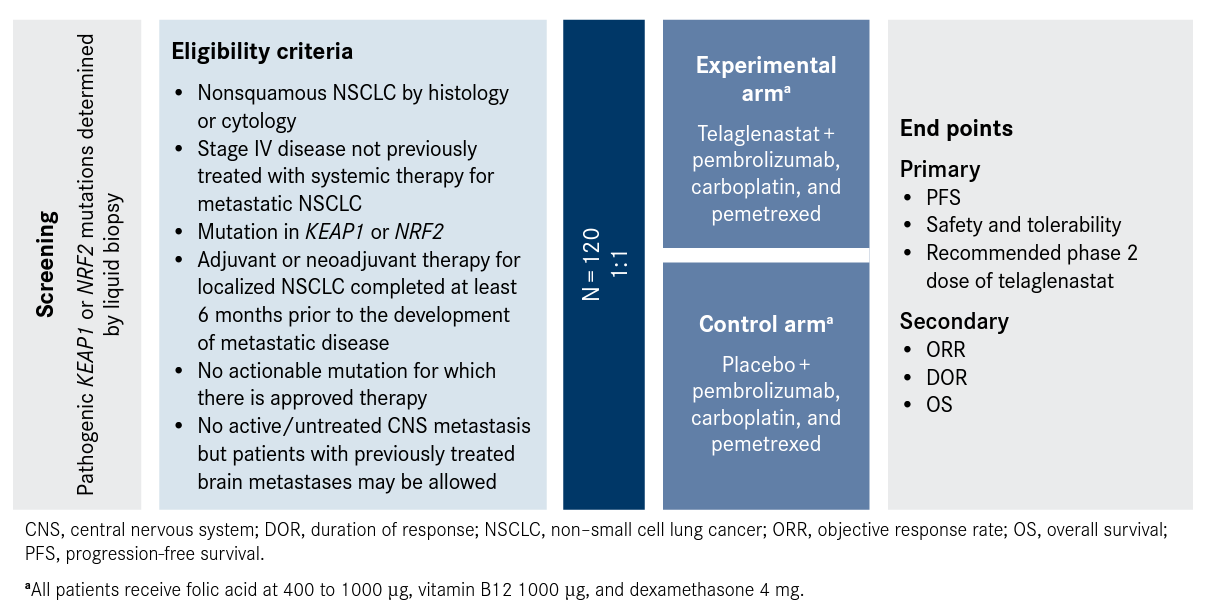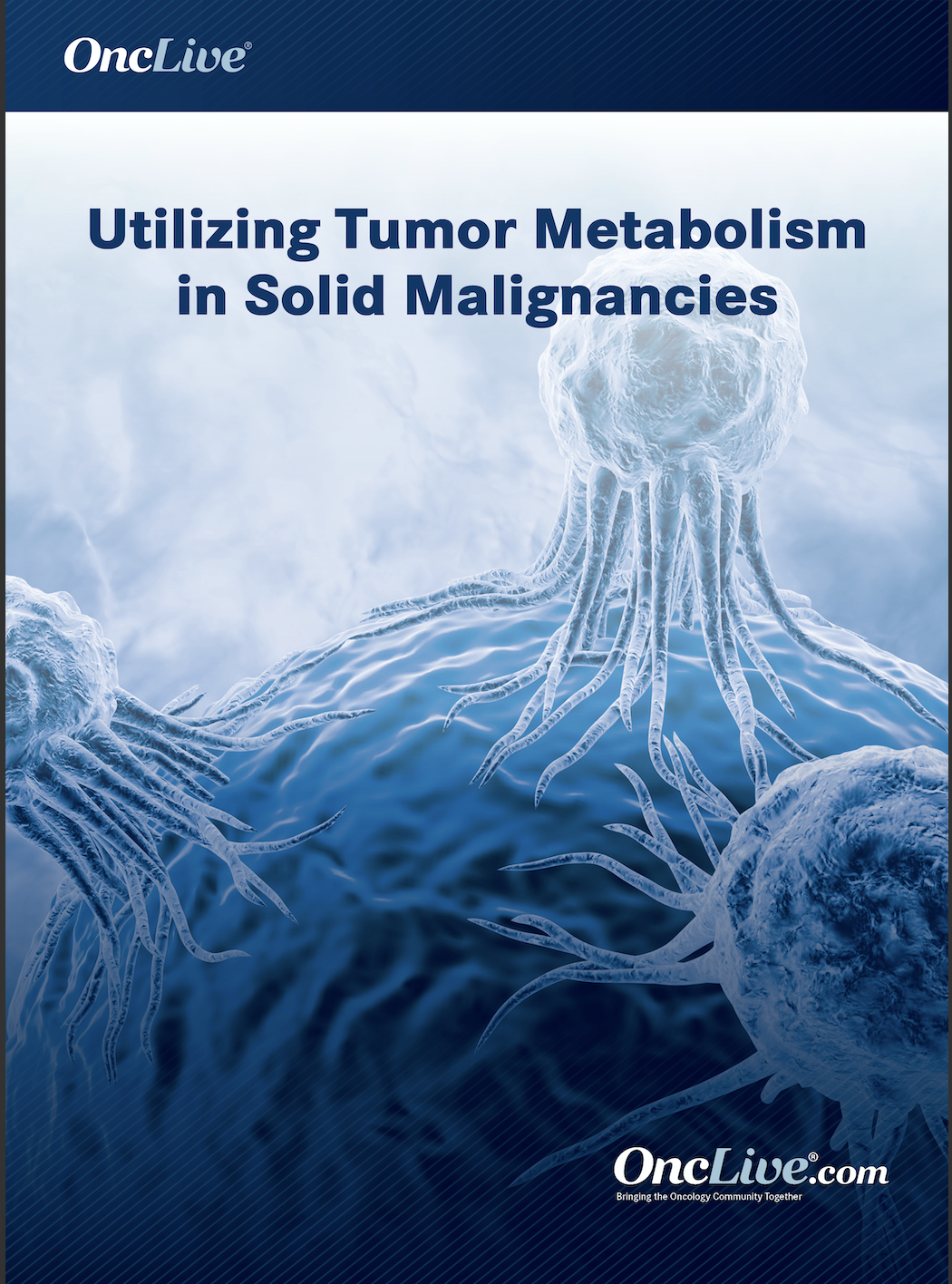Publication
Article
Investigators Tackle New NSCLC Target With Glutaminase Inhibitor
Author(s):
Telaglenastat, a novel drug that targets a key metabolic pathway, has shown encouraging antitumor activity in several cancer types.
Naiyer A. Rizvi, MD

Telaglenastat (CB-839), a novel drug that targets a key metabolic pathway, has shown encouraging antitumor activity in several cancer types. Now, investigators have launched the phase 2 KEAPSAKE trial to evaluate the agent in combination with standard-of-care chemoimmunotherapy as a first-line treatment for patients with metastatic nonsquamous non–small cell lung cancer (NSCLC) with KEAP1 or NRF2 mutations.
Patients whose tumors harbor these mutations do not respond well to treatment, even with the best standard of care, said Naiyer A. Rizvi, MD, the principal investigator on the KEAPSAKE study. Rizvi is the Price Family Professor of Medicine, director of thoracic oncology, and codirector of cancer immunotherapy at Columbia University Herbert Irving Comprehensive Cancer Center in New York, New York.
In NSCLC, KEAP1 or NRF2 mutations occur in more than 20% of patients but no drugs that specifically target these alterations have been approved, according to a presentation by Rizvi at the 2020 American Society of Clinical Oncology Virtual Scientific Program.1 “KEAP1 mutations are the third most common tumor mutation in lung adenocarcinoma [after TP53 and KRAS2], so they are very common,” he said. “NRF2 mutations are seen in both squamous and nonsquamous histology.” Dysregulated activity of the KEAP1/NRF2 pathway promotes tumor growth and survival, investigators have found. “These KEAP1 mutations are highly dependent on glutamine metabolism. Glutamine is metabolized to glutamate for DNA protein synthesis but it also converts to glutathione, which protects the cancer cells from oxidative stress,” said Rizvi, who is the research director of the Price Family Comprehensive Center for Chest Care at NewYork-Presbyterian Hospital. “Preclinical models show that if you block glutamine metabolism with telaglenastat, you can increase the oxidative stress within the tumors and allow for potentially better tumor destruction when you give this with standard-of-care treatments.”
In the KEAPSAKE trial (NCT04265534), participants will be randomized to receive telaglenastat in combination with pembrolizumab (Keytruda), a PD-1 inhibitor, plus carboplatin and pemetrexed (Alimta) versus placebo with pembrolizumab and the chemotherapy combination (Figure).3 Telaglenastat will be administered orally with food at 800 mg twice daily in combination with standard-of-care pembrolizumab plus chemotherapy by intravenous (IV) infusion every 3 weeks. Patients will be assessed every 3 months for up to 3 years.
The primary end points are progression-free survival (PFS) per RECIST 1.1 criteria and safety and tolerability of telaglenastat. Secondary end points include objective response rate, duration of response, and overall survival.
The trial results will be stratified by STK11/LKB1 mutational status1; alterations in these genes have been associated with lack of response to standard therapy with pembrolizumab. Additionally, KEAP1 is significantly co-mutated with STK11.4
KEAPSAKE, which recently opened for recruitment, is expected to enroll 120 patients in 57 study locations in the United States. Eligible patients must have stage IV nonsquamous NSCLC that has not been previously treated in the metastatic setting and no EGFR, ALK, ROS1, or other actionable mutation for which there is already an approved therapy.
KEAP1/NRF2 mutation status will be determined by next-generation sequencing using the Guardant360 CDx assay, which analyzes genetic alterations in circulating cell-free DNA extracted from the plasma of peripheral whole blood.5 In August 2020, the FDA approved Guardant360 CDx as a companion diagnostic for osimertinib (Tagrisso) to identify EGFR exon 19 deletions, L858R substitutions, and the T790M resistance mutation in patients with NSCLC. The test also is approved as a tumor profiling assay for NSCLC.6
“The testing is an advantage for the patients, even if they don’t have a KEAP1 mutation. They get this commercial assay that looks for not just KEAP1 mutations but other mutations within the panel as well. There is information to be gained no matter what your mutational status is or whether you go on the trial or not,” Rizvi said in an interview.
Figure. Telaglenastat Plus Chemoimmunotherapy in KEAP1/NRF2-Mutated, Nonsquamous NSCLC3
Phase 2 KEAPSAKE Trial

Early Efficacy Findings for Telaglenastat
Preclinical testing has shown that loss of KEAP1 activates NRF2 and promotes lung adenocarcinoma. In one study, it was shown that KEAP1/NRF2-mutated cancers are likely to respond to glutaminase inhibition.7
In an ongoing phase 1/2 study (CX-839004; NCT02771626), telaglenastat was evaluated in combination with the PD-1 inhibitor nivolumab (Opdivo) in patients with advanced NSCLC who progressed on prior PD-1/PD-L1 inhibitor therapy. Patients with KEAP1 mutations had a higher clinical benefit rate (CBR) and longer median PFS than those without these mutations.1
Among participants tested for KEAP1 mutations, the CBR was 75% in those with the alteration (3 of 4 patients) versus 15% in those without it (2 of 13 patients), with CBR defined as a combination of complete and partial responses and stable disease. The median PFS was 6.4 months for patients with the KEAP1 mutation compared with 3.7 months for those with wild-type KEAP1, with responses evaluated using modified RECIST 1.1 criteria for immune-based therapies.1
Additionally, telaglenastat has demonstrated antitumor activity in patients with previously treated advanced or metastatic clear cell renal cell carcinoma (RCC) in the phase 2 ENTRATA trial (NCT03163667). Patients in the double-blind study were randomized 2:1 to telaglenastat in combination with everolimus (Afinitor), an mTOR inhibitor (n = 46), or placebo plus everolimus (n = 23).8
The telaglenastat combination doubled the median PFS to 3.8 months versus 1.9 months with the everolimus combination (HR, 0.64; 95% CI, 0.34-1.20; 1-sided P = .079). The most frequently reported grade 3 or higher adverse effects in the treatment arm versus the control group, respectively, were anemia (17.4% vs 17.4%), pneumonia (6.5% vs 4.3%), abdominal pain (6.5% vs 0%), thrombocytopenia (6.5% vs 0%), and fatigue (4.3% vs 8.7%).8
Telaglenastat is currently being evaluated in the phase 2 CANTATA trial (NCT03428217), in which telaglenastat in combination with cabozantinib (Cabometyx) is being compared with placebo plus cabozantinib in patients with previously treated advanced or metastatic RCC. The primary end point is PFS.
Findings from the study, which has completed enrollment of 444 patients, are expected late in 2020 or early in the first quarter of 2021, according to Calithera Biosciences, the company developing telaglenastat.9
Telaglenastat is also being studied in combination with azacitidine (Vidaza) in a single-arm phase 1/2 study (NCT03047993) in patients with intermediate- and high-risk myelodysplastic syndromes. Findings from an interim analysis involving 19 patients were presented at the 2019 American Society of Hematology Annual Meeting. The regimen demonstrated an overall response rate of 65%, including complete responses of 11%, a 1-year overall survival rate of 50%, and 1-year event-free survival rate of 33%.10
References
- Skoulidis F, Neal JW, Akerley WL, et al. A phase II randomized study of telaglenastat, a glutaminase (GLS) inhibitor versus placebo, in combination with pembrolizumab (pembro) and chemotherapy as first-line treatment for KEAP1/NRF2-mutated non-squamous metastatic non- small cell lung cancer (mNSCLC). J Clin Oncol. 2020;38(suppl 15):TPS9627. doi:10.1200/JCO.2020.38.15_suppl. TPS9627
- Best SA, Sutherland KD. “Keaping” a lid on lung cancer: the Keap1-Nrf2 pathway. Cell Cycle. 2018;17(14):1696-1707. doi:10.1080/15384101.2018.1496756
- KEAPSAKE: a study of telaglenastat (CB-839) with standard-of-care chemoimmunotherapy in 1L KEAP1/NRF2-mutated, nonsquamous NSCLC (KEAPSAKE). ClinicalTrials.gov. Updated September 21, 2020. Accessed September 29, 2020. https://clinicaltrials.gov/ct2/show/NCT04265534
- Skoulidis F, Arbour KC, Hellman MD, et al. Association of STK11/LKB1 genomic alterations with lack of benefit from the addition of pembrolizumab to platinum doublet chemotherapy in non-squamous non-small cell lung cancer. J Clin Oncol. 2019;37(suppl 15):102. doi:10.1200/ JCO.2019.37.15_suppl.102
- Calithera Biosciences initiates KEAPSAKE randomized phase 2 trial of telaglenastat in combination with chemoimmunotherapy to treat aggressive form of lung cancer. News release. Calithera Biosciences Inc. September 24, 2020. Accessed October 4, 2020. https://bit.ly/3lhejhx
- Summary of safety and effectiveness data (SEED). Guardant360 CDx. FDA. August 7, 2020. Accessed October 4, 2020. https://www.accessdata.fda.gov/cdrh_docs/ pdf20/P200010B.pdf
- Romero R, Sayin VI, Davidson SM, et al. Keap1 loss promotes Kras-driven lung cancer and results in a dependence on glutaminolysis. Nat Med. 2017;23(11):1362-1368. doi:10.1038/nm.4407
- Data from randomized phase 2 ENTRATA study demonstrate telaglenastat with everolimus improves progression-free survival in renal cell carcinoma. News release. Calithera Biosciences Inc. September 29, 2019. Accessed September 28, 2020. https://bit.ly/2HXvruD
- Calithera Biosciences reports second quarter 2020 financial results and recent highlights. News release. Calithera Biosciences. August 10, 2020. Accessed September 29, 2020. https://bit.ly/3itozl9
- Guerra VA, Burger JA, Borthakur GM, et al. Interim analysis of a phase II study of the glutaminase inhibitor telaglenastat (CB-839) in combination with azacitidine in advanced myelodysplastic syndrome (MDS). Blood. 2019;134(suppl 1):567. doi:10.1182/blood-2019-125970










